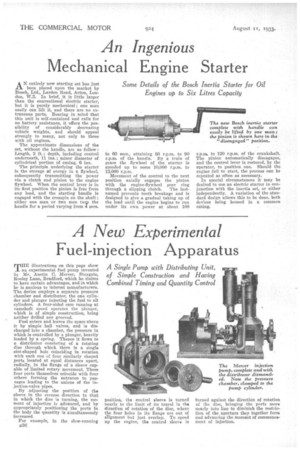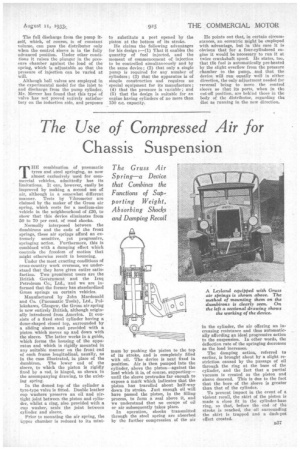A New Experimental Fuel-injection Apparatus
Page 46

Page 47

If you've noticed an error in this article please click here to report it so we can fix it.
TIIE illustrations on this page show an experimental fuel pump invented by Mr. Austin C. Mercer, Staygate, Rooley Lane, Bradford, which he claims to have certain advantages, and in which he is anxious to interest manufacturers. The device employs a separate pressure chamber and distributor, the one cylinder and plunger injecting the fuel to all cylinders. A four-sided cam running at camshaft speed operates the plunger, which is of simple construction, being neither drilled nor grooved.
Fuel enters and leaves the space above it by simple ball valves, and is discharged into a chamber, the pressure in which is controlled by a plunger, heavily loaded by a spring. Thence it flows to a distributor consisting of a rotating dice through which there is a single slot-shaped bole coinciding in rotation with each one of four similarly shaped ports located at equal distances apart, radially, in the flange of a sleeve capable of limited rotary movement. These four ports themselves coincide with four others forming the entrance to passages leading to the unions of the injection-valve pipes.
By adjusting the position of the sleeve in the reverse direction to that in which the disc .4g turning, the moment of injection is advanced, and by appropriately positioning the ports in the body the quantity is simultaneously increased.
For example, in the slow-running 1336 position, the control rs lac v a is turned nearly to the limit of its travel in the direction of rotation of the disc, where the four holes in its flange are out of alignment but just overlap. To speed up the engine, the control sleeve is
turned against the direction of rotation of the dise, bringing the ports more nearly into line to diminish the restriction of the aperture they together form and advancing the moment of commencement of injection.
The full discharge from the pump itself, which, of course, is of constant volume, can pass the distributor only when the control sleeve is in the fully advanced position. Under other conditions it raises the plunger in the pressure chamber against the load of the spring, which is adjustable so that the pressure of injection can be varied at will.
Although ball valves are employed in the experimental model for the inlet to and discharge from the pump cylinder, Mr. Mercer has found that this type of valve has not proved entirely satisfactory on the induction side, and proposes to substitute a port opened by the piston at the bottom of its stroke.
He claims the following advantages for his design :—(1) That it enables the quantity of fuel injected, and the moment of commencement of injection to be controlled simultaneously and by the same device; (2) that only a single pump is required for any number of cylinders ; (3) that the apparatus is of simple construction and requires no special equipment for its manufacture ; (4) that the pressure is variable ; and (5) that the design is suitable for an engine having cylinders of no more than 150 c.c. capacity. Be points out that, in certain circumstances, an eccentric might be employed with advantage, but in this case it is obvious that for a four-cylindered engine it would be necessary to run it at twice crankshaft speed. He states, too, that the fuel is automatically pre-heated by the slight overflow from the pressure chamber to the pump, and that the device will run equally well in either direction, the only adjustment needed for reversal being to move the control sleeve so that its ports, when in the cut-off position, are behind those in the body of the distributor, regarding the disc as running in the new direction.




















































































